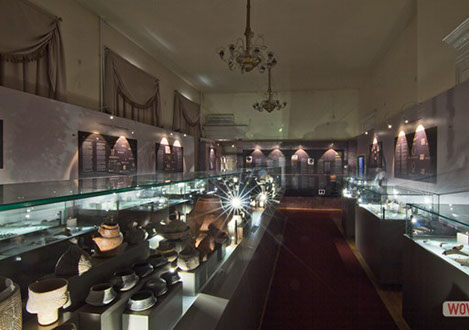- Address: Bd. I.C. Brătianu, no. 2
- Telephone: 021 315 68 58 (Secretariat), 0722 574 897 (Public Relations)
- E-mail: relatii.publice@muzeulbucurestiului.ro
- Secretariat office hours : Monday – Thursday, 10:00 – 15:00
- Visiting hours:
-
- Wednesday – Sunday, 10:00 – 18:00
- Ticket office closes at 17:30
- Subway Access – M2 Line (Blue), Universitate Station
- R.A.T.B. (Bus): 61, 66, 69, 70, 85, 90, 91
- 14 lei – full price ticket
- 7 lei – discounted ticket for schoolchildren, students, retirees, military personnel, organised groups
- 11 lei / person – guided tour price. Guided tours are only available for groups over 15 people, with prior booking via email at relatii.publice@muzeulbucurestiului.ro, 5 days before the desired date for the tour.
- Entry is free for preschoolers and persons with disabilities.
The Suţu Palace is one of the oldest aristocratic residences in Bucharest, as well as one of the very few buildings that have remained unchanged for over 150 years. It was built between 1833 and 1835 by Costache Suţu, according to the designs of architects Conrad Schwink and Johann Veit.
The palace’s interior was designed in 1862 by Karl Storck, renowned sculptor and decorative artist. He is responsible for the monumental double-winder set of stairs leading to the first floor, and for adding a beautiful gilded-frame mirror, brought all the way from Murano, Italy. The sculpted wooden medallion representing Irina Suţu, the owner’s spouse, rests right above the mirror.
The second half of the 19th century was the Palace’s Golden Age. The first ball of the year was organised here, every February. Grigore Suţu (1819-1893) and his wife Irina, daughter of famed banker Ştefan Hagi Moscu, had fully dedicated themselves to maintaining an authentic ambiance typical of aristocratic residences.
The Palace was a private residence until the 20th century, and in 1956 it became the Bucharest Municipality Museum’s new headquarters, opening to the general public later the same year. Since its inauguration, the museum has housed numerous collections and exhibitions related to the history of Bucharest, as well as to other aspects of life in the city, displaying valuable heritage from archaeological sites, donations and acquisitions, thanks to the funds provided by the City Hall every year.
The Palace’s main exhibition was redone, and was reopened on May 15th 2015. The new permanent exhibition, called “Time of the City”, aims to help visitors delve into a story-driven journey through the city’s history.
Starting with a unique piece found within the Palace – the backwards running clock, fabricated by the Collin House of Paris, a clock that requires people to view its mirrored reflection in order to tell time – the “Time of the City” exhibition is a journey that begins in the present and heads back in time, towards the past.
This pilgrimage is segmented, as each room housing the exhibition is dedicated to a certain historical period of reference for the city’s evolution and for the events that occurred on its territory.
Aside from the Time of the City, the museum usually houses a number of other smaller exhibitions, related to art, history, culture, and other interesting elements or events related to the city of Bucharest.














































